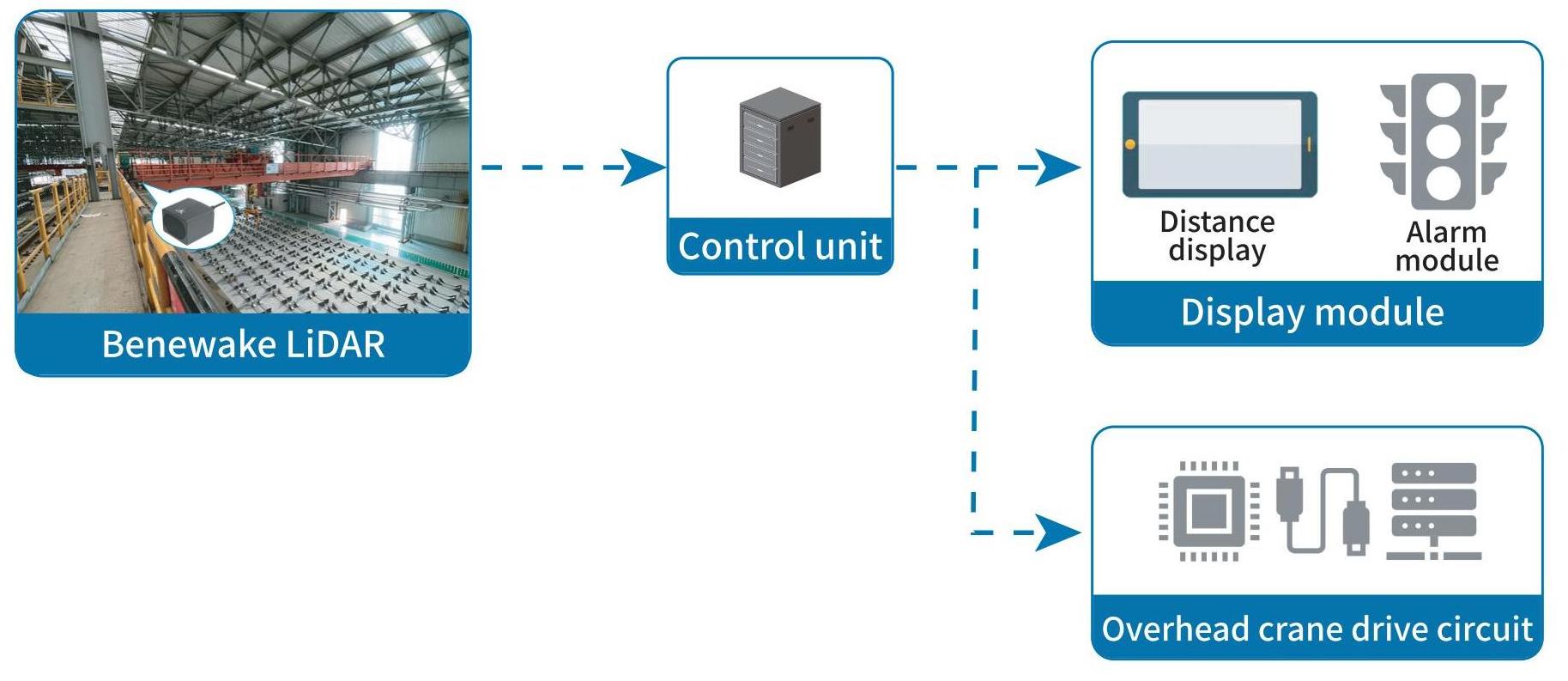Long Distance Series Product Model

Overhead cranes are essential equipment for lifting and transporting materials in large factories and workshops, commonly found in industries such as metallurgy, papermaking, and construction materials. In large workshops, multiple overhead cranes often operate simultaneously on the same track, undertaking heavy workloads. Collisions between cranes, often caused by delayed braking, can significantly impact production efficiency and even result in employee safety incidents.
Collision prevention devices for overhead cranes measure the distance between cranes on the same track in real-time. They can also monitor the distance between a crane and the end of the track, set safety alert distances, control the crane to decelerate or stop, and promptly notify the operator to pay attention to the distance between cranes. These devices are crucial for the safe operation of overhead cranes. Benewake's single-point LiDAR modules offer a wide range of models that are unaffected by environmental light and other interferences. With a maximum range of up to 350 meters, centimeter-level measurement accuracy, a detection frequency of up to 1000Hz, and a design tailored for industrial environments with IP65/67 protection ratings, these modules provide stable and reliable distance measurement results for overhead crane collision prevention systems.

1. Solution Diagram


3. Solution Description
Based on the different directions of crane operation, the system determines whether the area ahead is occupied by another crane or the end of the track and sets different alert zones accordingly. As shown in the red area of the diagram, the zone within distance L2 from the crane is designated as the collision prevention zone, or emergency braking area (Zone ①). The slightly farther zone, depicted in yellow, where the distance D between cranes is between L1 and L2, is designated as the deceleration zone (Zone ②). Any area where the distance is greater than L1 is considered the normal driving zone (Zone ③).
For cranes moving in the same direction, the deceleration threshold L1 is typically set to 15 meters. The LiDAR continuously measures the real-time distance D between two cranes. When D is less than the L1 threshold, the crane decelerates. The emergency braking threshold is usually set to 5 meters. If the real-time distance D between two cranes falls below the L2 threshold, the crane performs an emergency stop to prevent collisions.
If the crane is moving towards the end of the track with no other cranes in between, the deceleration threshold L1 is typically set to 10 meters, and the emergency braking threshold L2 is set to 3 meters.
When the distance falls within the alert zones, the system triggers the audio-visual alarm module to alert the operator to drive safely.

4. Installation Method
Install a Benewake LiDAR on both sides of the crane's direction of travel to detect the left and right side distances. The two LiDAR units are mounted on opposite corners of the crane to prevent interference from direct line-of-sight between the LiDAR units of two adjacent cranes. Align the LiDAR with the target or object, using an indicator laser and infrared camera to ensure the LiDAR beam's center is aimed accurately at the target.

1. Designed for high-speed operation scenarios, with a default detection frequency of 100Hz, configurable up to 1000Hz, ensuring rapid and timely response.
2. Outputs real-time distance values and signal strength values, with simple data parsing, allowing for more reliable processing when combined with strength values.
3. Rich interface options, supporting various data interfaces such as UART/I²C/4-20mA/RS-232/RS-485.
4. Strong anti-interference capability, with environmental light resistance of 100 Klux; highly adaptable with no requirements for reflective objects, eliminating the need for extra installation of high-reflectivity reflective plates.
5. Small Field of View (FoV), low false alarm rate, precise distance measurement, compact size, and easy integration within the crane body.